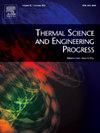壁挂式燃气锅炉积灰和腐蚀机理:成分分析和热效率影响
IF 5.1
3区 工程技术
Q2 ENERGY & FUELS
引用次数: 0
摘要
本研究系统地研究了四种24kw壁挂式燃气锅炉的积灰和腐蚀机理。定量分析表明,腐蚀成分约占冷凝锅炉灰渣的90%,主要包括Fe/Cr/Ni金属氧化物、SiO2和CaSO4。Si、Ca、S对壁挂式燃气锅炉的结灰和腐蚀有显著影响。SiO2颗粒主要来源于空气粉尘,易在换热盘管表面积灰。S主要来自天然气中的含硫组分,如H2S、硫醇等。当铝硅酸盐、CaSO4、碱盐等无机矿物沉积在换热盘管表面时,S、硫酸盐等腐蚀性介质进一步加剧了对受热面材料的腐蚀。随着灰的累积,热效率呈非线性恶化。在典型的运行条件下(0.8 mm的标称线圈间距),当灰层厚度达到0.35 mm的临界阈值时,传热效率将严重降低75%。适当增大换热器盘管之间的间隙,可以有效缓解表面灰垢对热效率的影响。本文章由计算机程序翻译,如有差异,请以英文原文为准。
Mechanisms of ash deposition and corrosion in wall-mounted gas boilers: Compositional analysis and thermal efficiency impacts
This research systematically investigates ash deposition and corrosion mechanisms in four types of 24 KW wall-mounted gas boilers. Quantitative analysis reveals that corrosive components constitute approximately 90 wt% of condensing boiler ash deposits, predominantly comprising Fe/Cr/Ni metal oxides, SiO2 and CaSO4. Si, Ca, and S have a significant impact on the ash deposition and corrosion of wall-mounted gas boilers. SiO2 particles mainly come from air dust and were prone to ash deposition on the surface of heat exchange coils. S mainly comes from sulfur-containing components in natural gas, such as H2S and thiols. When inorganic mineral such as aluminosilicate, CaSO4, and alkali salts deposit on the surface of the heat exchange coil, corrosive media such as S and sulfate further intensify the corrosion of the heating surface material. A nonlinear deterioration of thermal efficiency was observed with progressive ash accumulation. Under typical operating conditions (0.8 mm nominal coil spacing), the heat transfer efficiency experiences a severe 75 % reduction when ash layer thickness reaches the critical threshold of 0.35 mm. Appropriately increasing the gap between heat exchanger coils can effectively mitigate the impact of surface ash on thermal efficiency.
求助全文
通过发布文献求助,成功后即可免费获取论文全文。
去求助
来源期刊

Thermal Science and Engineering Progress
Chemical Engineering-Fluid Flow and Transfer Processes
CiteScore
7.20
自引率
10.40%
发文量
327
审稿时长
41 days
期刊介绍:
Thermal Science and Engineering Progress (TSEP) publishes original, high-quality research articles that span activities ranging from fundamental scientific research and discussion of the more controversial thermodynamic theories, to developments in thermal engineering that are in many instances examples of the way scientists and engineers are addressing the challenges facing a growing population – smart cities and global warming – maximising thermodynamic efficiencies and minimising all heat losses. It is intended that these will be of current relevance and interest to industry, academia and other practitioners. It is evident that many specialised journals in thermal and, to some extent, in fluid disciplines tend to focus on topics that can be classified as fundamental in nature, or are ‘applied’ and near-market. Thermal Science and Engineering Progress will bridge the gap between these two areas, allowing authors to make an easy choice, should they or a journal editor feel that their papers are ‘out of scope’ when considering other journals. The range of topics covered by Thermal Science and Engineering Progress addresses the rapid rate of development being made in thermal transfer processes as they affect traditional fields, and important growth in the topical research areas of aerospace, thermal biological and medical systems, electronics and nano-technologies, renewable energy systems, food production (including agriculture), and the need to minimise man-made thermal impacts on climate change. Review articles on appropriate topics for TSEP are encouraged, although until TSEP is fully established, these will be limited in number. Before submitting such articles, please contact one of the Editors, or a member of the Editorial Advisory Board with an outline of your proposal and your expertise in the area of your review.
 求助内容:
求助内容: 应助结果提醒方式:
应助结果提醒方式:


